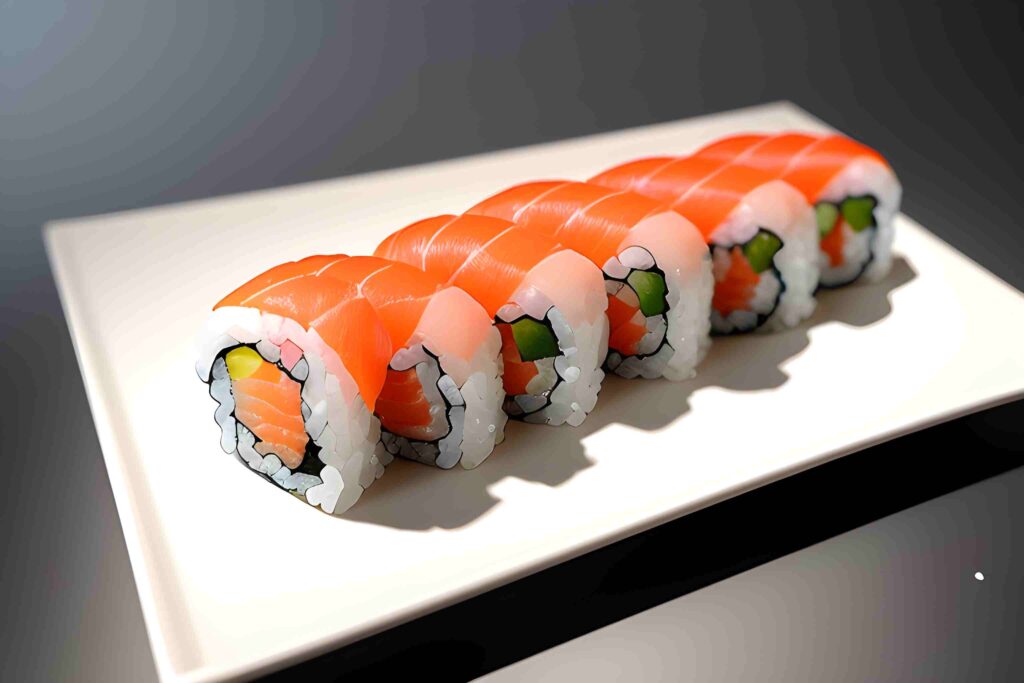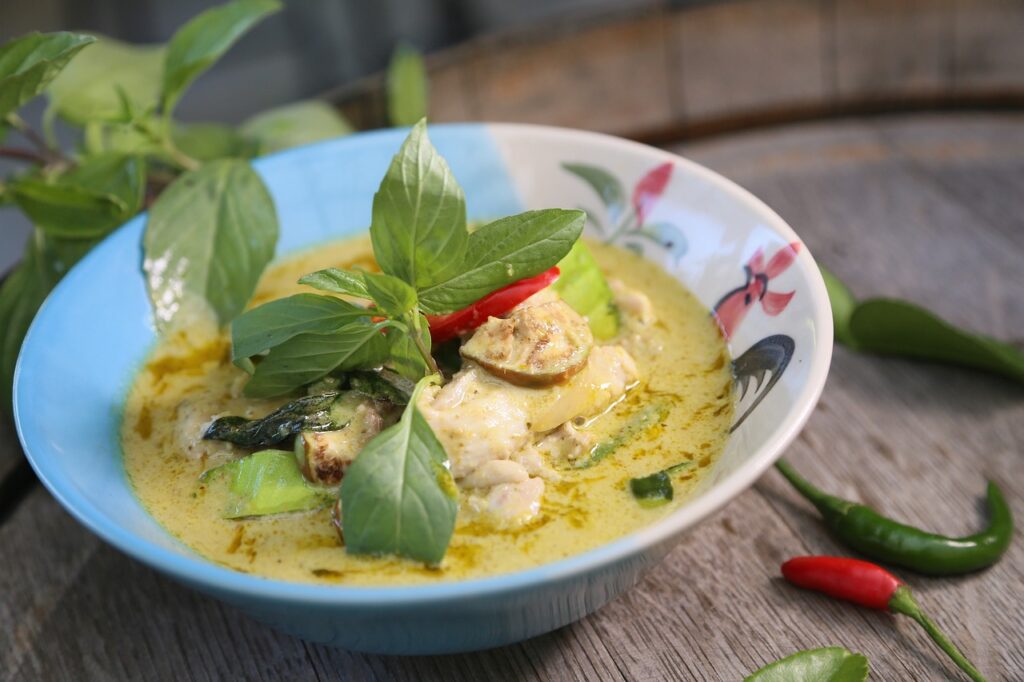This post may contain affiliate links which means I may receive a commission for purchases made through links.
Table of Contents

Introduction:
In the vast realm of culinary delights, fusion cuisine has emerged as a captivating trend that has captured the hearts and palates of food enthusiasts worldwide. This innovative culinary approach takes inspiration from different cultures, ingredients, and techniques, blending them harmoniously to create an entirely new gastronomic experience. Today, we embark on an exhilarating exploration of the captivating world of “Japanese and Thai Asian Fusion” cuisine, where the art of sushi intertwines with the vibrant flavors of Thai and other Asian cuisines.
When we hear the keywords “Japanese and Thai Asian fusion,” our taste buds awaken, envisioning a symphony of flavors that transcend cultural boundaries. It’s a culinary fusion that artfully combines the delicate elegance of Japanese sushi with the bold, aromatic spices and herbs found in Thai cuisine, along with other vibrant Asian influences. This unique blend of flavors takes us on a remarkable journey where every bite offers a harmonious dance of tastes and textures, creating an experience that is both familiar and refreshingly new.
Prepare to be enchanted by the intricate balance of umami from sushi, the tantalizing heat from Thai spices, and the nuanced aromas that pervade the air. Each dish represents a marriage of culinary traditions, a captivating fusion of diverse flavors that results in an extraordinary culinary symphony for the senses. From Thai-inspired sushi rolls bursting with vibrant fillings to innovative dishes that infuse the delicate art of sushi with the bold flavors of Thai cuisine, the possibilities are boundless.
As we delve into the world of Japanese and Thai Asian fusion, get ready to embark on an exhilarating journey that will expand your culinary horizons. We invite you to join us as we explore the artistry, the innovation, and the irresistible allure of this remarkable fusion cuisine. It’s a celebration of the diversity and creativity that thrives in the culinary landscape, where tradition meets innovation, and where flavors collide to create something truly extraordinary.
So fasten your seat belts and prepare your taste buds for a one-of-a-kind experience as we dive into the captivating realm of Japanese and Thai Asian fusion cuisine. Get ready to discover bold new flavors, embrace unexpected combinations, and indulge in a fusion that transcends borders. This is a culinary adventure you won’t want to miss, as we uncover the secrets behind the enchanting blend of Japanese and Thai Asian fusion. Let the exploration begin!.
Section 1: The Art of Sushi
Sushi, a true culinary masterpiece, traces its origins back to ancient Japan, where it emerged as a method of preserving fish. What started as a simple preservation technique eventually evolved into an art form celebrated worldwide for its exquisite flavors and meticulous craftsmanship.
The history of sushi dates back over a thousand years when fish was salted and fermented with rice to extend its shelf life. This method, known as narezushi, was prevalent during the Muromachi period. However, it wasn’t until the Edo period in the 19th century that sushi took on its familiar form.The traditional sushi-making process involves a meticulous combination of skilled preparation, precise technique, and the use of premium ingredients. It begins with the selection of the freshest fish, known as sashimi-grade fish, which is renowned for its high quality and taste. Other ingredients like vegetables, seaweed, and condiments are carefully chosen to complement the flavors and textures of the sushi.
The heart of sushi lies in the vinegared rice, known as shari or sushi rice. This rice is cooked to perfection and seasoned with a delicate balance of rice vinegar, sugar, and salt. The mastery of sushi chefs lies in achieving the ideal texture and flavor of the rice, which should be slightly sticky yet retain a distinct individual grain. Sushi chefs, known as itamae, demonstrate immense skill and precision as they artfully shape the sushi. They craft various types of sushi, such as nigiri (hand-pressed sushi) and maki (sushi rolls), each requiring a unique technique. Nigiri showcases a slice of fish or seafood delicately placed on a small mound of sushi rice, while maki involves wrapping the rice and fillings in a sheet of nori (seaweed) and slicing it into bite-sized pieces.
The artistry of sushi lies not only in its visual presentation but also in the balance of flavors. Each piece is carefully crafted to harmonize the umami of the fish or seafood with the slight acidity of the seasoned rice. Accompaniments such as soy sauce, wasabi, and pickled ginger add a layer of complexity to the overall dining experience, enhancing the flavors without overpowering the delicate taste of the sushi.
Today, sushi has transcended its humble origins and become an internationally acclaimed dish, beloved by food enthusiasts across the globe. Its popularity stems from the unique combination of flavors, the impeccable presentation, and the sheer artistry that goes into its creation. Sushi represents a delightful culinary experience that awakens the senses, offering a taste of Japanese culture and a testament to the mastery of culinary craftsmanship.
As we explore the realm of Japanese and Thai Asian fusion, we can expect the traditional art of sushi-making to intertwine with the vibrant flavors of Thai and other Asian cuisines, resulting in an extraordinary blend of tastes and textures. This fusion of culinary traditions promises to create a remarkable dining experience that pushes the boundaries of creativity and indulges the palate in a symphony of flavors.
Section 2: The Vibrant Thai Cuisine

Thailand, with its rich culinary heritage, is a treasure trove of vibrant flavors and aromatic ingredients that have captivated the world’s taste buds. Thai cuisine is renowned for its perfect balance of sweet, sour, spicy, and savory notes, creating a harmonious symphony of taste sensations. Thai cuisine’s distinct flavors come from a variety of ingredients that form the backbone of its culinary traditions. From the fresh herbs and spices to the abundant use of coconut milk, each element contributes to the unique character of Thai dishes. The cuisine often incorporates ingredients like lemongrass, galangal, kaffir lime leaves, Thai basil, and bird’s eye chili, infusing the dishes with their distinct aromas and flavors.
One hallmark of Thai cuisine is its ability to strike a fine balance between flavors. The sweet and tangy notes of tamarind and lime are juxtaposed with the fiery heat of chili peppers, creating an explosion of taste on the palate. The use of fish sauce, a quintessential Thai condiment, adds a complex umami depth to many dishes, while palm sugar brings a delicate sweetness. Among the vast array of Thai dishes, several have gained international acclaim for their distinct flavors and popularity. Pad Thai, a stir-fried noodle dish, perfectly showcases the harmonious blending of flavors with its combination of rice noodles, shrimp or chicken, bean sprouts, eggs, and a medley of seasonings such as tamarind, fish sauce, and lime.
Green Curry, a classic Thai dish, exemplifies the bold flavors and vibrant colors of the cuisine. It combines a rich coconut milk base with green curry paste, featuring ingredients like Thai basil, green chilies, lemongrass, and kaffir lime leaves. The addition of meat or vegetables creates a sumptuous dish that is best savored with fragrant jasmine rice.
Tom Yum Soup, known for its invigorating and tangy flavors, is a Thai culinary gem. This hot and sour soup typically combines lemongrass, galangal, kaffir lime leaves, chili peppers, and lime juice, creating a refreshing and zesty broth. With the addition of shrimp, mushrooms, and aromatic herbs, Tom Yum Soup becomes a delightful explosion of flavors that is both comforting and invigorating.
Thai cuisine encompasses an extensive range of dishes, from fiery curries to refreshing salads and aromatic stir-fries. The use of fresh, vibrant ingredients combined with a delicate balance of flavors makes Thai cuisine an unforgettable culinary experience. As we explore the fusion of Japanese and Thai Asian cuisine, the vibrant flavors and aromatic ingredients of Thai cuisine will intertwine with the artistry of sushi-making, offering a tantalizing blend that promises to be a feast for the senses. The combination of Thai herbs, spices, and condiments with the delicate nuances of sushi creates a fusion that is both exciting and harmonious, elevating the dining experience to new heights.
Section 3: The Allure of Asian Fusion
Section 3: The Allure of Asian Fusion
Asian fusion cuisine has taken the culinary world by storm, captivating food enthusiasts with its innovative approach and harmonious blend of diverse flavors. This exciting culinary concept involves the fusion of ingredients, techniques, and influences from various Asian cultures, resulting in a truly unique and tantalizing dining experience. At the heart of fusion cuisine is the desire to create something new and exciting by combining the best elements of different culinary traditions. It is a celebration of culinary diversity and creativity, where chefs push the boundaries and challenge traditional norms to craft dishes that surprise and delight.
In the realm of Japanese and Thai Asian fusion, we witness the marriage of two distinct yet complementary culinary traditions: the art of sushi-making and the vibrant flavors of Thai cuisine. This fusion brings together the precision and elegance of Japanese sushi with the bold, aromatic spices and herbs found in Thai dishes. The result is a culinary symphony that harmonizes the delicate umami of sushi with the fiery, tangy, and refreshing flavors that define Thai cuisine.
Japanese and Thai Asian fusion exemplifies the boundless creativity and innovation that comes with this culinary approach. Chefs and culinary artists explore new possibilities, experimenting with novel ingredient combinations, inventive presentations, and imaginative flavor profiles. The fusion of Japanese and Thai flavors provides a unique canvas for culinary expression, allowing chefs to create dishes that seamlessly blend the best of both worlds.
The allure of Japanese and Thai Asian fusion lies in its ability to surprise and delight the palate. It offers a fresh take on familiar ingredients and techniques, infusing them with unexpected twists and vibrant flavors. From Thai-inspired fillings in sushi rolls to incorporating sushi elements into traditional Thai dishes, the possibilities are endless. The fusion of these culinary traditions opens up a world of endless creativity, where chefs can break free from traditional confines and craft dishes that transcend cultural boundaries.
Moreover, Japanese and Thai Asian fusion reflects the evolving nature of our globalized world. It symbolizes the cultural exchange and cross-pollination of ideas that occur in our interconnected society. This fusion cuisine serves as a testament to the rich tapestry of flavors and influences that shape our culinary landscape, offering a culinary experience that is both nostalgic and refreshingly new. As diners, we are invited to embark on a gastronomic adventure, where every bite reveals the ingenuity and ingenuity of the culinary artists behind Japanese and Thai Asian fusion. It is an opportunity to indulge in flavors that transcend borders, to experience the harmonious dance of Japanese and Thai traditions on our taste buds. The allure of this fusion lies not only in its delectable offerings but also in the story it tells, a story of cultural exchange, creativity, and the relentless pursuit of culinary excellence.
Section 4: Exploring Japanese and Thai Asian Fusion
Japanese and Thai Asian fusion cuisine presents a vibrant and diverse range of dishes that merge the artistry of sushi-making with the bold flavors of Thai and other Asian culinary traditions. This fusion delights the senses with its innovative combinations, unique ingredients, and captivating presentation styles. In Japanese and Thai Asian fusion, the menu offers an exciting array of dishes that showcase the best of both worlds. Thai-inspired sushi rolls take center stage, featuring creative fillings and toppings that infuse the rolls with the vibrant flavors of Thai cuisine.
Picture sushi rolls with a delightful blend of fresh Thai herbs like basil, mint, and cilantro, along with fiery chili peppers, tangy tamarind, and zesty lime. These rolls encapsulate the essence of Thai flavors while maintaining the elegant form and technique of sushi.Another intriguing aspect of Japanese and Thai Asian fusion is the incorporation of Thai curries with sushi rice. Imagine indulging in a creamy green curry made with coconut milk, Thai basil, and kaffir lime leaves, served atop a bed of perfectly seasoned sushi rice.
This fusion of flavors results in a dish that combines the creaminess and spiciness of the curry with the delicate texture and subtle tang of sushi rice, creating a culinary harmony that is both comforting and exhilarating. One of the hallmarks of Japanese and Thai Asian fusion is the use of unique ingredients and techniques. Chefs often experiment with cross-cultural ingredients such as Thai spices, aromatic herbs, tropical fruits, and even elements of Japanese and Thai street food. These elements blend seamlessly to create dishes that surprise and excite the palate. Techniques from both culinary traditions, such as sushi rolling and Thai stir-frying, are employed to craft innovative and visually stunning creations.
The presentation style in Japanese and Thai Asian fusion is an art form in itself. Chefs skillfully combine the elegance of sushi plating with the vibrant and colorful aesthetics of Thai cuisine. The dishes are often garnished with fresh herbs, edible flowers, and intricate sauces, creating visually appealing compositions that entice diners even before the first bite. The attention to detail and the balance of colors and textures showcase the culinary craftsmanship and the passion of the chefs behind each dish.
As diners delve into the realm of Japanese and Thai Asian fusion, they embark on a culinary journey that celebrates the harmonious blending of flavors, textures, and cultural influences. It is an exploration of unique ingredients, innovative techniques, and stunning presentations that push the boundaries of creativity. Japanese and Thai Asian fusion cuisine provides an opportunity to experience the best of Japanese sushi and Thai flavors in a single bite, offering a culinary adventure that is as visually captivating as it is tantalizing to the taste buds.
Section 5: Cooking Japanese and Thai Asian Fusion at Home
Cooking Japanese and Thai Asian fusion dishes in the comfort of your own kitchen is an exciting and rewarding experience. Here are some beginner-friendly dishes that you can easily recreate to embark on your culinary adventure of fusion flavors. While I won’t disclose the specific recipes and instructions here, I’ll provide a glimpse of the mouthwatering possibilities that await you.
Flavorful Thai-Inspired Sushi Rolls:
Imagine the delicate artistry of sushi rolls combined with the vibrant flavors of Thai cuisine. These fusion sushi rolls feature a creative medley of ingredients and toppings that infuse the rolls with the tantalizing taste of Thai herbs, spices, and condiments. With a harmonious balance of flavors and textures, these sushi rolls will leave you craving for more.
Sushi Rice Bowls with Thai Twist:
Indulge in the blissful harmony of sushi rice and Thai-inspired flavors in a delightful rice bowl. These bowls bring together the best of both worlds, combining perfectly seasoned sushi rice with a burst of Thai-infused ingredients. With an array of vibrant vegetables, tender meats or seafood, and aromatic herbs, these rice bowls will transport your taste buds to a realm of fusion bliss.
Delectable Thai Curries with a Sushi Rice Twist:
Immerse yourself in the rich and creamy world of Thai curries with a unique twist. These fusion dishes feature the lusciousness of Thai curries infused with the delicate tang and texture of sushi rice. Imagine the delectable combination of tender meats or vegetables enveloped in a velvety coconut milk-based curry, harmonizing with the subtle flavors of perfectly cooked sushi rice.
So, grab your apron, gather the ingredients, and embark on a culinary journey that blends the best of Japanese sushi and Thai flavors. With a spirit of exploration and a dash of creativity, you’ll be able to savor the delightful fusion of Japanese and Thai Asian cuisine right in your own kitchen.
Conclusion:
In conclusion, Japanese and Thai Asian fusion cuisine presents a remarkable fusion of flavors that brings together the best of Japanese sushi and the vibrant tastes of Thai cuisine. The unique combination of delicate sushi techniques with the bold and aromatic spices of Thailand creates a culinary experience that is both tantalizing and unforgettable.
One of the remarkable aspects of Japanese and Thai Asian fusion is its versatility and creativity. It offers a wide range of dishes, from Thai-inspired sushi rolls to delectable rice bowls and curry creations with a sushi rice twist. This culinary style allows chefs and home cooks alike to unleash their imagination, experimenting with ingredients, flavors, and presentations to craft dishes that transcend cultural boundaries and traditional norms.
By indulging in Japanese and Thai Asian fusion, you embark on a journey of exploration, discovering new flavors and combinations that excite your taste buds. The blending of diverse culinary traditions opens up a world of possibilities, inviting you to savor the harmonious marriage of flavors and textures that this fusion cuisine offers.
Whether you’re a seasoned sushi lover or an avid fan of Thai cuisine, Japanese and Thai Asian fusion cuisine provides an opportunity to expand your culinary horizons and discover the delightful symphony of flavors that arises from this fusion. Embrace the spirit of adventure, and allow your palate to be delighted by the inventive combinations, vibrant colors, and tantalizing aromas that this culinary style has to offer.
So, don’t hesitate to explore the world of Japanese and Thai Asian fusion. Whether you’re dining at a fusion restaurant or trying your hand at recreating these dishes in your own kitchen, immerse yourself in the rich tapestry of flavors that await you. Indulge in the versatility and creativity of this culinary style, and let your taste buds be your guide as you embark on a gastronomic adventure like no other.
